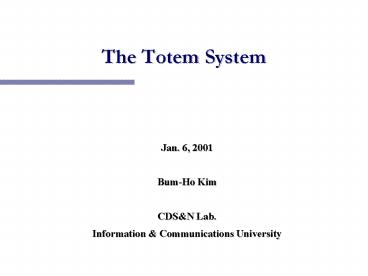The Totem System PowerPoint PPT Presentation
1 / 17
Title: The Totem System
1
The Totem System
- Jan. 6, 2001
- Bum-Ho Kim
- CDSN Lab.
- Information Communications University
2
Introduction
- Totem
- Logical token-passing ring
- Single-ring protocol
- Reliable totally ordering
- Configuration change service
- Multiple-ring protocol
- Global total ordering
- Network topology maintenance service
- Process group interface
- Deliver group membership service
3
Single-Ring Protocol (1)
- Token
- Circulate around the ring
- Only processor holding the token can broadcast a
message - Total ordering
- Rapid detection of faults
- Effective flow control
4
Single-Ring Protocol (2)
- Message Ordering
- Agreed delivery
- Sequence number field in the token
- Total order on message
- Provides a single sequence of message sequence
numbers for all messages - Detecting gaps requesting retransmission in
retransmission requesting field in token
5
Single-Ring Protocol (3)
- Message Ordering
- Safe delivery
- All-received-upto field
- After a full token rotation, processor can
determine all processors have received all
messages with lower sequence numbers - Reclaim the buffer space
6
Single-Ring Protocol (4)
- Local Configuration Services
- Consensus
- Reducing the membership until consensus is
reached in bounded time - First Configuration Change message
- Introducing a transitional configuration of
reduced size - Indicating that the agreed and safe delivery
guarantees apply only to the transitional
configuration - the remaining messages of the old configuration
are delivered - Second Configuration Change message
- Introducing new regular configuration
7
Multiple-Ring Protocol (1)
- Model
- Multiple LANs interconnected by gatways
- Each gateway connects a pair of LANs, but a pair
of LANs is connected directly by at most one
gateway - Combine sequence numbers and timestamps
- Provide a global total order of messages across
multiple interconnected LANs - Network partitioning remerging, and processor
failure and recovery
8
Multiple-Ring Protocol (2)
- Services
- Reliable Ordered Delivery
- Total Ordering Lamport timestamp
- Deliver messages and topology changes in
timestamp order - Messages with the same timestamp are delivered in
the order of source ring id - Topology Maintenance Services
- Topology Change messages are generated by the
multiple-ring protocol as a result of a
configuration change
9
Multiple-Ring Protocol (3)
- Reliable Ordered Delivery
- A gateway broadcasts a forwarded message
- Provides the message with a new sequence number
to be reliably delivered on a ring - The timestamp remains unchanged to be delivered
in the same total order on all rings
10
Multiple-Ring Protocol (4)
- Reliable Ordered Delivery
- Delivery in Agreed Order
- Processor has the recv_msgs list for all of the
rings - If message is the lowest timestamp message and
the recv_msgs list for all of the rings are
non-empty - Guarantee Vector messages
- A gateway periodically generates broadcast
- A processor is not delayed for long by the lack
of a message - Contains a guarantee vector
11
Multiple-Ring Protocol (5)
- Reliable Ordered Delivery
- Delivery in Safe Order
- guarantee_vector
- Highest timestamp of any message received from
the corresponding ring - All entries in the column of the guarantee_array
for the source ring must be at least equal to the
timestamp of the message - All of the processors and gateways have received
the message
12
Multiple-Ring Protocol (6)
- Example
13
Multiple-Ring Protocol (7)
- Topology Maintenance Services
- Each gateway maintains a data structure
- Current view of the network topology
- Handling of Configuration Changes
- Configuration change is Reported by a
Configuration Change message generated by
single-ring protocol - The gateways analyze the Configuration Change
message to determine its effect on the network
topology - Topology Change messages are generated by the
multiple-ring protocol as a result of a
configuration change
14
Multiple-Ring Protocol (8)
- Topology Maintenance Service
- Handling of Configuration Changes
- Topology Change messages and Configuration Change
messages are delivered to the process group layer - To forwards information about membership to the
application - All processors agree on logical time for topology
change and on messages delivered before and after
the topology change - All messages are processed in timestamp order
15
Flow Control
- Flow control
- Performance is limited by input buffer overflow
under high loads - Token provide accurate information
- The number of message transmitted during the
previous token rotation - Limit transmissions
- To ensure that input buffers seldom overflow
16
Conclusion
- Totem System
- Ring-based
- Extended Virtual Synchrony
- Recovery, Partition, Remerge
- Reliable Ordered Delivery
- Multiple LANs
17
References
- Totem System
- Y. Amir, L. E. Moser, P. M. Melliar-Smith, D. A.
Agarwal, and P. Ciarfella, The Totem Single-Ring
Ordering and Membership Protocol, ACM
Transactions on Computer Systems 13, 4 (Nov.
1995), 311-342. - D. A. Agarwal, L. E. Moser, P. M. Melliar-Smith,
and R. Budhia, Reliable Ordered Delivery Across
Interconnected Local-Area Networks, Proceedings
of the International Conference on Network
Protocols, Tokyo, Japan (Nov. 1995), 365-374. - L. E. Moser, P. M. Melliar-Smith, D. A. Agarwal,
R. K. Budhia, and C. A. Lingley-Papadopoulos,
Totem A Fault-Tolerant Multicast Group
Communication System, Communications of the ACM,
April 1996.

